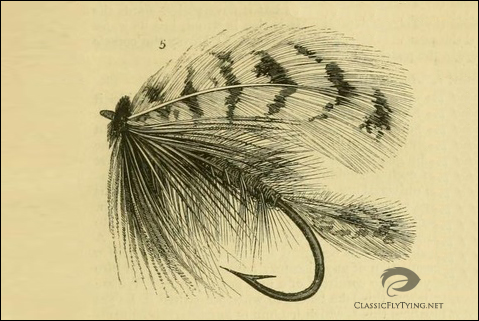Encyclopedia of Rural Sports, 1870.
There are many pattern descriptions to be found in the Encyclopediea of Rural Sports, but most of them are borrowed from other books. Bainbridge, Salmonia, Taylor, Williamson and Lascelles are ignored for this listing, choosing to highlight eight wonderful plates and their descriptions instead. These wonderful drawings are without a doubt, exactly how these flies are supposed to look.
The following text is quoted from this wonderful book.
Sect. II. Artificial Flies used in Salmon Fishing.
On the subject of artificial flies for the taking of salmon. If we were to say, that in this place we had any thing very novel to offer, we should be guilty of angling quackery ; for although we have dressed many salmon flies, yet we never did it on any particular principle except custom or local usage, because we think these fish are influenced by caprice oi a love of play as much as by any choice in the nature of their insect food. They certainly rise to the artificial bee, wasp, tenthredines, etc. ; but they do it just as readily, and even more so, to a jumble of gaudy feathers representing every thing and nothing. We shall therefore select from different writers, either such flies as they themselves particularly recommend, or such as we can recommend from having successfully used them ; and elsewhere we shall offer some engravings of the most killing salmon flies now used by our most successful salmon anglers.
No. 1

Tag: Silver tinsel
Tail: Scarlet mohair.
Butt: Black Ostrich herl.
Wing.: Black turkey with a white tip.
Body: Blue mohair or pig’s wool.
Ribs: Flat silver tinsel.
Hackle: Black hackle.
Throat: A guinea-fowl’s feather.
Head: Black Ostrich.
No. 2.

Tag: Gold tinsel.
Tail: Orange mohair.
Body: Crimson mohair or pig’s wool.
Ribs: Gold twist.
Hackle: Blood red hackle.
Throat: Blood red, shouldered full.
Wing: Brown mottled Turkey.
Head: Peacock herl of a brilliant hue.
No. 3.

Tag: Silver tinsel.
Tail: Brown Mallard, Brown Teal, Brown Peacock and Mallard dyed yellow.
Butt: Peacock herl
Body: Crimson mohair at the head, green mohair in the middle, and yellow silk at the tail.
Ribs: Silver twist.
Hackle: Blood red hackle.
Throat: Guinea Fowl.
Wing: Argus Pheasant.
Head: Peacock herl.
No. 4.

Tag: Silver tinsel.
Tail: Scarlet mohair.
Butt: Black Ostrich herl.
Body: Green mohair, or pig’s wool.
Ribs: Oval silver tinsel.
Hackel: Dun hackle.
Wing: Brown mottled Turkey.
Head: Black Ostrich herl.
No.5.

Tail: Bittern’s feather.
Body: Blue dun mohair, or wool.
Hackle: Dun hackle.
Throat: A coarse dun feather.
Wing: Whole feather of the Bittern.
Head: Black Ostrich herl.
No. 6.

Tag: Gold tinsel.
Tail: Scarlet mohair.
Butt: Green Peacock herl.
Body: Dirty yellow mohair, or wool.
Ribs: Gold twist (see note)
Hackle: A greyish dun hackle.
Throat: Guinea hen.
Wing: Heron or Red Kite.
Head: Green Peacock herl.
Note: This fly is sometimes dressed with and sometimes without gold twist, according to the nature of the water for depth, clearness, etc. If deep and at all discoloured the fly cannot be made too conspicuous.
No. 7.

Tail: Crimson mohair.
Butt: Gold tinsel.
Body: Orange mohair, or wool.
Ribs: Oval gold tinsel.
Hackle: Red hackle.
Throat: A red and black hackle.
Wing: Bittern.
Head: Peacock herl.
No.8.

Tag: Silver tinsel.
Tail: Yellow mohair.
Butt: Peacock herl.
Body: Light olive mohair, or wool.
Ribs: Silver twist.
Hackle: A ginger hackle.
Throat: Grouse.
Wing: A mixture of Bittern, Brown Mallard, Teal, and Heron.
Head: Peacock herl.
The book also lists two “personal favorites”, without crediting them to any specific author. Their descriptions are as follows:
Two Salmon Flies for the Scottish Highlands
No. 16 – the Jay
Body: Green Ostrich herl
Ribs: Gold lace.
Hackle: Bright orange over the upper half of the body.
Wing: Barred Jay feathers back to back.
Head: Scarlet.
No. 17 – the Peacock
Tail: Two green strands of Peacock’s eye feather herl for tail whishs.
Body: Orange mohair.
Ribs: Silver tinsel.
Throat: Two turns of a dark hackle
Wing: Two eyes of a small Peacock tail feather, or two Peacock crest feathers back to back.

